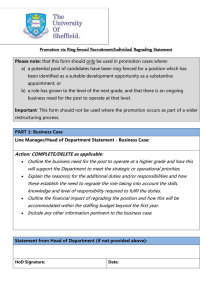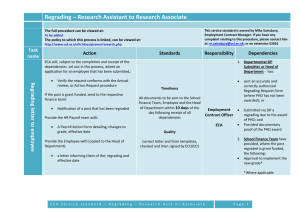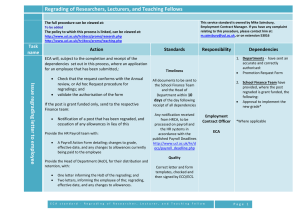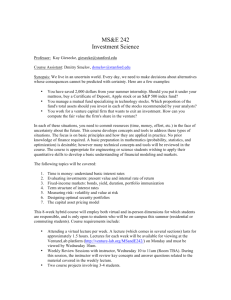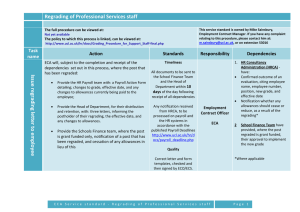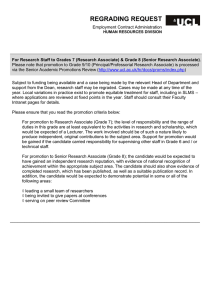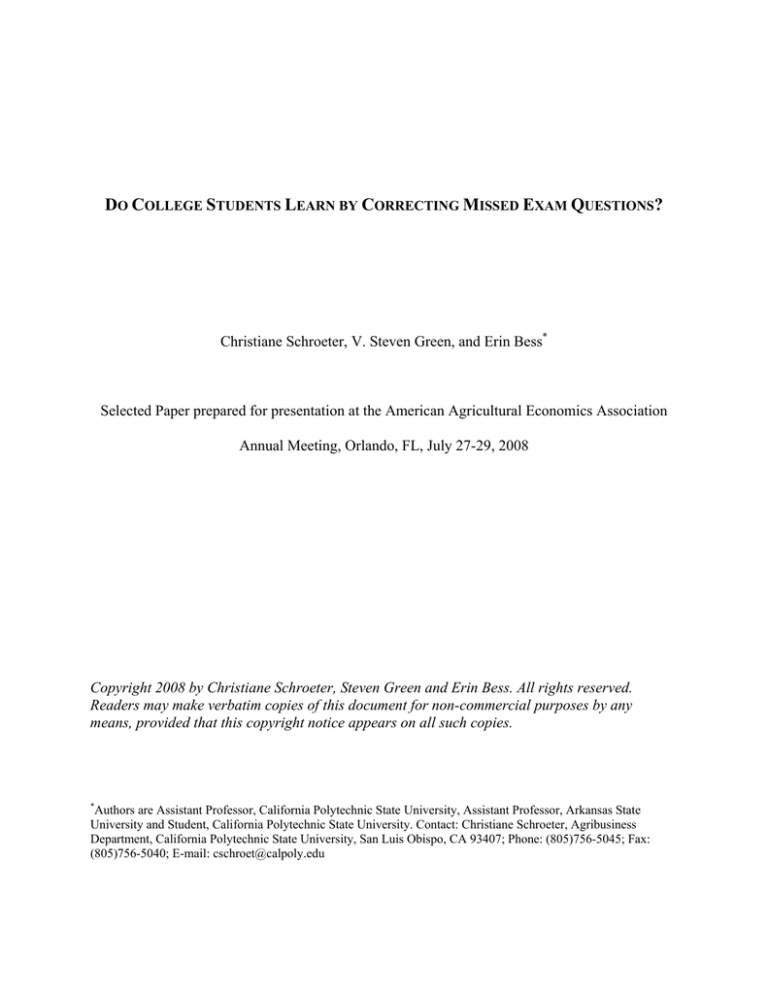
DO COLLEGE STUDENTS LEARN BY CORRECTING MISSED EXAM QUESTIONS?
Christiane Schroeter, V. Steven Green, and Erin Bess*
Selected Paper prepared for presentation at the American Agricultural Economics Association Annual Meeting, Orlando, FL, July 27-29, 2008 Copyright 2008 by Christiane Schroeter, Steven Green and Erin Bess. All rights reserved.
Readers may make verbatim copies of this document for non-commercial purposes by any
means, provided that this copyright notice appears on all such copies.
*
Authors are Assistant Professor, California Polytechnic State University, Assistant Professor, Arkansas State
University and Student, California Polytechnic State University. Contact: Christiane Schroeter, Agribusiness
Department, California Polytechnic State University, San Luis Obispo, CA 93407; Phone: (805)756-5045; Fax:
(805)756-5040; E-mail: cschroet@calpoly.edu
DO COLLEGE STUDENTS LEARN BY CORRECTING MISSED EXAM QUESTIONS? ABSTRACT
This study determines the learning benefit of correcting missed exam questions. The results show
that in addition to exams being an assessment tool, they can also be used as a tool for student
learning. The availability of this information will provide help considering design, development,
and improvement of traditional assessment methods for student learning.
KEYWORDS: Student learning, Assessment, Exam
1
INTRODUCTION AND OBJECTIVES The mission of the university is to guide students in learning specific fundamental principles for
life-long learning. Assessment methods, such as exams, test the student’s understanding of the
material and provide feedback to students and professors (McKeachie, 1999). However, given
that exams provide an impetus for students to study the class material, they typically only
evaluate the student’s knowledge at the time the exam is given. The typical lifecycle of an exam
ends after it has been corrected by the professor and returned to the student. Risley (2007)
observed an exam lifecycle similar to what we have observed: 1) Student takes exam, 2)
professor grades exam, 3) professor returns graded exam, 4) student looks at grade, sees what
they missed, checks to make sure points were added correctly, 5) places exam in notebook,
maybe never to be looked at again until time to study for the final exam. Few students take the
time to determine why they missed a question and to work the problem or answer the question
correctly. Factors such as student procrastination and busy exam schedules frequently lead to
last-minute studying behavior, which may question the efficacy of exams as a tool to help
students with knowledge retention. Thus, there is a need to explore whether student learning
could be enhanced by modifying the traditional lifecycle of exams.
Light (1990) interviewed thousands of students to determine the qualities of the best
courses they had taken at the university. In his study, students expressed that one of the
characteristics of the highest ranked courses includes “the opportunity to revise and improve
their work before it receives a final grade, thereby learning from their mistakes in the process”
(Light, 1990, pp. 8-9). This finding is supported by Bain (2004) who suggests it is important to
give students multiple chances to demonstrate their comprehension when administering an exam.
Thus, one alternative to the traditional exam lifecycle would be to allow the student to review the
2
graded exam material, correct their missed exam questions, and return them to the professor for
re-grading. Although some studies have addressed the usefulness of correcting missed exam
questions (Risley, 2007), to our knowledge, no study has assessed the learning benefits of this
alternative exam lifecycle.
The objectives of this study are to (1) identify student perceptions of correcting missed
exam questions and to (2) compare the learning benefit of this alternative method to the
traditional exam lifecycle that ends with the professor returning the exam. Our study will assess
whether correcting missed exam questions assists a student in better understanding the required
course material. We include subjective and objective measures of student learning. Student
learning is measured subjectively by assessing students’ perceptions about their learning of the
material, while the objective measurement determines the students’ overall performances
resulting from the traditional vs. the alternative exam lifecycle. The availability of this study’s
information will be useful in considering design, development and improvement of traditional
assessment methods for student learning.
RESEARCH METHODOLOGY
Study Design
Students enrolled in various classes at Arkansas State University and California Polytechnic
State University San Luis Obispo were selected to participate in a regrading study to assess the
value of correcting missed exam questions on student learning. Students were placed into the
regrading or non-regrading sample based solely on whether the class they were enrolled in
3
offered this option during that semester/quarter.* Thus, the entire class in a particular
semester/quarter was either in the regrading or non-regrading sample. Students in the regrading
sample were notified at the beginning of the semester/quarter that they would have the
opportunity to correct missed questions on the exam and return them to the professor to be
regraded. If the regraded questions were solved correctly, the student could receive up to half of
the missed points for each question that was redone correctly. For example, if a student missed 5
points on a question worth 10 points, they could earn back 2.5 points if they correctly answered
the question before returning it for regrading. Students were required to return the exams for
regrading by the next class period; late papers were not accepted.
Students in the non-regrading sample were not told anything about this alternative
learning method. However, word travels among students between semesters/quarters such that
students in the non-regrading sample often asked if regrading would be offered to them.
Response to these students was simply that it was not being offered that particular
semester/quarter.
The regrading survey was distributed to the students at the end of the semester/ quarter
that they had the opportunity to correct the missed exam questions and submit the corrections for
regrading. Similarly, the non-regrading survey was distributed to students at the end of the
semester/quarter during which they did not have the opportunity to correct the missed exam
questions.
*
While Arkansas State University follows the semester system, California Polytechnic State University is based on
the quarter system.
4
Survey Design
In this study, a written survey was used to collect college student data (18 years or older). The
survey included questions regarding student demographics, perceptions about the opportunity to
correct missed exam questions, and their perception about their own learning. To carry out a
complete investigation of the issue, this study was administered with two different student
samples with different sets of surveys. Thus, a regrading survey and a non-regrading survey were
designed. The students with the non-regrading survey served as the control group, since their
assessment methods were based on the traditional lifecycle of an exam and they did not receive
the incentive points to make the corrections to their missed exam questions, although some
students may have likely corrected missed exam questions on their own accord. Thus, survey
questions were based on the hypothetical situation of having the regrading opportunity. The
questions in the non-regrading group were very similar to the regrading survey, in order to allow
for a detailed comparison by question.
Data Collection
The written survey was administered at Arkansas State University from Spring 2006 until Fall
2007.† In addition, data was collected at California Polytechnic State University, San Luis
Obispo during Fall 2007. This cross-state administration allowed for interesting comparisons,
especially considering the geographic, demographic, and cultural diversity of the two
universities.
The survey participants attended lower and upper level agricultural science courses and
agribusiness courses. Subjects were selected based on the class in which they were enrolled and
†
Data of the Spring 2008 semester/ quarter is currently collected. The analysis will appear in a later version of this
paper.
5
their participation in this study was voluntary.
The first sample is the regrading group, since it was collected from students who had the
opportunity to re-submit the answers to missed questions from their course exams for re-grading.
The regrading group consisted of 189 students. The second sample underwent the traditional
exam lifecycle. This non-regrading group consisted of 52 students‡ and it served as the control
group.
RESULTS
This study employed five types of variable groups: 1) demographics; 2) study habits; 3) method
of correcting missed exam questions, 4) test anxiety and preparation; and 5) post-exam learning.
Demographics: Several demographic variables may impact student learning such as age, gender,
marital and employment status, year in school, and the university attended. Table 1 shows that
the average age was very similar in the regrading and the non-regrading group, with 22 years in
the regrading group and 21 years in the non-regrading group.
Study habits: In order to assess the general study habits of the students, questions about the
number of credit hours during the semester/ quarter, number of hours worked, and number of
hours studied were included. Furthermore, the survey asked whether the student typically does
the required class readings and whether the class is required for their major. Table 2 shows that
48% of the students in the non-regrading group and 42% of the students in the regrading sample
typically do the required readings for class. The majority of students in both samples stated that
‡
Additional data using the non-regrading survey will be collected during May 2008. With this additional data, the
sample size of the control group will be about 110 students.
6
the classes were required for their major, with 94% in the non-regrading sample and 91% in the
regrading sample. The average number of credit hours per semester/ quarter was similar in both
treatment groups, with about 14 credit hours per semester/ quarter. However, the number of
hours worked differed widely, with a mean of 32 hours worked per week in the non-regrading
group and a mean of 23 hours worked per week in the regrading group. The greater average
number of hours worked per week in the non-regrading group reflects that the control group
survey has only been administered to students at Arkansas State University to this point, where
the typical undergraduate student works on the farm or even a fulltime job while seeking a
university degree.
Method of correcting missed exam questions: The survey included questions about whether the
students took advantage of the opportunity to correct missed exam questions and how they
corrected these questions, such as working with other students, visiting the professor during
office hours or using the book/ notes. In the regrading group, 87% of the students stated that they
corrected their exams for regrading. The non-regrading group answered the hypothetical question
of whether they would have corrected their missed exam questions if regrading had been offered.
In this group, 78% of the students stated that they would have taken advantage of the opportunity
to have their exams regraded after making corrections. Figure 1 shows the method that students
in the regrading group used to correct missed exam questions. Of all students in the regrading
sample, 93% used their notes and books for correcting their missed exam questions. Our survey
suggests that the re-grading activity supports active and collaborative learning, since 79% of the
students worked together to solve the questions they missed on the exams. Furthermore, 40% of
7
the students visited the professor during office hours to get help with regrading. Only 17% of
students utilized other students’ exams to correct their missed exam questions.
Test anxiety and preparation: In addition, the survey assessed whether the opportunity for
regrading eased test anxiety or altered the study efforts for the exam. Both student samples had
positive perceptions about having the opportunity to correct missed exam questions. Figure 2
shows that 78% of the regrading group felt less text anxiety with the opportunity to regrade their
exams, and 82% of students in the non regrading group stated that the opportunity to regrade
their exam would have alleviated anxiety regarding test taking. However, the incentive to obtain
more points through regrading was an important motivator. More students in the regrading
sample took the time to correct missed exam questions when they were rewarded with additional
points for doing so as opposed to the students in the non-regrading sample who were not
rewarded directly with points. Figure 3 shows that 57% of students who had the opportunity to
regrade said that they would not have done so if no points were awarded for correcting their
missed exam questions. When asked a similar question, 78% of the non regrading group said that
they would correct a missed exam question if they felt it would enhance their learning of the
material. Thus, students tended to be idealistic in what would motivate them to make test
corrections, yet realistically, they appear to be more concerned about their grades than they are
about learning.
Post-exam learning: Both surveys included questions about students’ retaining the class material
after the exam in order to assess the benefits of the alternative exam lifecycle for student
learning. We collected subjective learning measures, such as their perceptions, in addition to
8
objective learning measures, such as their final course grades with vs. without the regrading
option. As figure 4 indicates, 86% of the students in the regrading sample felt that regrading their
tests was very useful and caused them to learn from their mistakes, where only 44% of the nonregrading group said that they learned from their mistakes. All students had the opportunity to
make corrections to learn from their mistakes, but only the students in the regrading treatment
had the extra incentive of gaining back points missed on the semester/quarter exams. Although
students indicated that they learned from their mistakes, an objective comparison of final exam
grades will need to be conducted to quantify whether or not their learning was realized and
whether it was sufficiently long term to score well on the final exam.
Limitations: A few limitations should be pointed out here. Given that the sample sizes of the
regrading vs. non-regrading group are still small, the results of the study are not sufficient yet to
clearly establish student learning by regrading. Thus, current results should be regarded as
preliminary. However, both sample sizes will become larger over time, as this project is still
ongoing and more data of both samples will be collected. It could also be argued that through
regrading a mere inflation of the students’ grades may occur. Risley (2007), however, found that
only about 18% of his students who participated in a similar regrading activity received a higher
semester/quarter course grade. His students, however, only had the opportunity to submit one of
three exams for regrading. In his study, the students had to choose which exam they would like
to submit for regrading. Thus, we might expect a greater percentage of higher grades from our
regrading sample due to the fact that they had the opportunity to submit all of their
semester/quarter exams except the final exam, for regrading.
9
Regrading does require a heavy time commitment for both the professor and the students.
However, the additional time students will spend on correcting their exam and working on class
material may be beneficial, as this repeated exposure to the material may add to their learning.
Given that the regrading option is not offered on the final exams of both treatment
groups, a comparison by final exam grades will show insight into student learning. Further data
collection will continue on a more detailed level, including a greater number of courses to be
evaluated. Additional information about student learning will be collected by repeating questions
from the semester/quarter exams on the final exam.
CONCLUSIONS
This study constitutes a unique contribution to the existing literature because it evaluates whether
altering a traditional assessment tool, such as exams, to extend the lifecycle of an exam to
include making corrections, can enhance student learning. Although based on a limited sample,
the results show that the opportunity to have corrected exams regraded eased student test anxiety
while adding to student learning as assessed by the students themselves. Furthermore, the survey
suggests that the additional opportunity for students to go over the exam again to correct missed
questions may help students to retain the information long term. The alternative exam lifecycle
also revealed students’ affinity for looking up correct answers and working together as opposed
to visiting the professor for assistance. Students overwhelmingly indicated a positive attitude
about having the opportunity to make corrections to missed exam questions for regrading. The
results of this study show that in addition to exams being an assessment tool, they can also be
used as a tool for student learning.
10
REFERENCES
Bain, K. What the best college teachers do. Cambridge: Harvard University Press, 2004.
Light, R. The Harvard Assessment Seminars. Cambridge: Harvard University, Graduate School
of Education and Kennedy School of Government, 1990.
McKeachie, W.J. McKeachie’s Teaching Tips. 11th edition. Boston: Houghton Mifflin
Company, 2002.
Risley, J M. “Reworking Exams To Teach Chemistry Content and Reinforce Student Learning”.
Journal Chemistry Education 84(2007):1445
11
APPENDIX: FIGURES AND TABLES
Table 1. Course Distribution and Time of Data Collection
Time of data
collection
Class
Non-Regrading Group
Total class
Respondents
enrollment
30
40
-
Regrading Group
Total class
Respondents
enrollment
18
21
13
14
25
28
Soil Fertility
Soil Sciences
Soil Sciences
Soil Sciences
Spring 2006
Fall 2006
Spring 2007
Fall 2007
Agricultural Statistics
Spring 2006
22
22
-
-
Agricultural Statistics
Fall 2006
-
-
29
35
Agricultural Statistics
Spring 2007
-
-
25
35
Agricultural Marketing
Spring 2007
-
-
11
12
Global Agricultural
Marketing
Fall 2007
-
-
34
44
Agricultural Economics
Fall 2007
-
-
34
41
52
62
189
230
Total number of students
Response rate
84%
82%
Table 2: Demographics and Study Habits of the Non-Regrading and Regrading Groups
Variable
Demographics
Average age
Study habits
Number of credit hours during the
semester/ quarter
Average number of hours worked per
week
Number of hours studied per week
Typically do assigned readings
Class required for major
Non-Regrading Group (n=52)
Regrading Group (n=189)
21
22
14
14.77
32.13
22.57
2.35
48.07%
94.23%
2.92
42.24%
90.96%
12
Percentage
Figure 1: Methods of Correcting Missed Exam Questions
100
90
80
70
60
50
40
30
20
10
0
Worked together with others
Test provided by other students
1
Other students showed me
Professor helped me
Used Books/ Notes
13
Figure 2: Test Anxiety in the Regrading Group
5%
8%
4%
5%
78%
Do Not Agree
Somewhat Disagree
14
Somewhat Agree
Agree
No Opinion
Figure 3: Test Anxiety in the Non-regrading group
4%
2%
12%
82%
Somewhat Disagree
Somewhat Agree
15
Agree
No Opinion
Figure 4: Learning from Mistakes in both groups
90
80
Percentage
70
60
50
40
30
20
10
0
Not at All
Useful
Regrading Group
Very Useful
Non Regrading Group
16
Unsure

